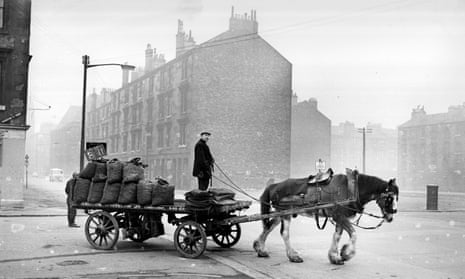Scientists are finalising plans to exploit the vast reservoir of warm water that fills a labyrinth of disused mines and porous rock layers underneath Glasgow. They believe this subterranean store of naturally heated water could be used to warm homes in the city. If the system proves successful, such water could then be exploited in other cities and towns across Britain, they say.
The £9m project will initially involve drilling narrow boreholes filled with instruments to survey temperature, seismic activity, water flow, acidity and other variables to establish the state of the water in the rocks below the city. The aim will be to establish whether this warm water can be extracted for long periods to heat Glaswegian homes.
“The rocks below Glasgow are crisscrossed with tunnels that were hewed into the rock by coalminers in the 19th and 20th century,” said Professor Michael Stephenson, the director of science at the British Geological Survey (BGS), which is funding the project. “Eastern Glasgow was once the location of some of Scotland’s busiest mines. These old, long-abandoned tunnels should now be allowing water to flow freely beneath the city.”
Because the reservoir of subterranean warm water is now linked by the tunnels, engineers believe they will not have to worry that water will dry up at an individual location when they drill a borehole.
Drilling of the first test boreholes – at sites yet to be selected – is the first part of an initiative by the BGS: the creation of several UK geo-energy observatories. Where other observatories look up to the sky, these will monitor conditions underground, say scientists. One test system has been selected for Scotland: the Glasgow Geothermal Energy Research Field Site. A second has been proposed for Cheshire – where scientists want to study rock conditions to assess the possibility of using underground vaults as storage for heated water.
“At present it is very hard to store energy and that is a problem when using renewable power plants – such as wind plants – which operate intermittently,” said Stephenson. “Our second borehole array, again crammed with instruments, would allow us to test the feasibility of storing water – heated by renewable power plants – and then releasing that energy later when it is needed.”
Heating of homes is set to become a crucial issue, researchers have warned. The UK is on target to decarbonise electricity generation as a result of the growing numbers of renewable power plants. However, the nation is still heavily reliant on North Sea and imported natural gas to heat its homes. Combustion of these fossil fuels forms a substantial part of the carbon dioxide emissions which the UK has pledged to reduceto help limit global warming.
“One solution would be to use the energy beneath our feet,” said Stephenson. “The temperature of the water that is sloshing through the old mines and in the rock layers under Glasgow is about 12C. That is not red hot, obviously. However, there is a great deal of water down there and by using heat exchangers we can turn that mass of lukewarm water into a moderate supply of very hot water which could be pumped into homes to provide hot water and heating in winter. At least that is the idea.” “Our underground observatory will determine whether it is feasible or not. It will analyse rates of replenishment, acidity, temperature and many other features. Based on that data we will know if we are on to a winner.”

Comments (…)
Sign in or create your Guardian account to join the discussion